This is Part I of a series on the Council on Accreditation (COA)’s 2020 Edition updates. Visit Part II here.
On January 15, 2020, we released an enhanced and refined set of private, public, and Canadian standards on our website. All of the work was done with a single goal in mind: to increase the value of accreditation by focusing on those practices and activities that will have the greatest impact on the people and communities COA-accredited organizations work with.
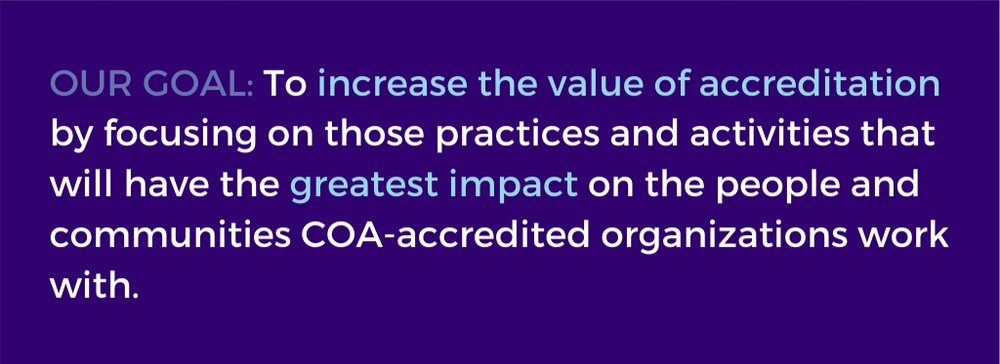
Our approach to the work
The COA 2020 Edition was the culmination of a review of the literature on organizational effectiveness and valuable feedback from our volunteers, organizations, and partners who provided critical insight into which aspects of COA’s accreditation process and standards were impactful to organizations and their clients, and which were not.
Our mission at COA is to partner with human and social service organizations to strengthen their ability to improve the lives of the people they serve. Our belief is that in order to have the greatest impact on clients, the entire organization—from Human Resources to Finance to those directly delivering services and beyond—must be working together to fulfill that organization’s mission. COA’s 2020 Edition was designed to highlight and strengthen that connection.
Refocusing the Self-Study process
In service of focusing accreditation on the standards that promote the development of effective, mission-driven organizations that are equipped to meet the needs of their clients over time, we have refined the standards to:
1. Give organizations more time to devote to those practices that have a more direct impact on clients, and
2. Allow organizations to spend less time compiling evidence and more time improving practice.
This is reflected in the 2020 Edition in multiple ways.
Firstly, in the years of work leading up to the 2020 Edition Standards launch, we sought to tighten what we ask of organizations. We eliminated or combined redundant standards within and across sections. We reorganized similar content whenever possible, and we eliminated overlap with state and government regulation.
We also sought to clarify expectations and delete what wasn’t needed. One way this was accomplished was by minimizing Interpretations within the standards including converting those that were informational in nature and not required into “Examples,” deleting those that were unnecessary or outdated, merging required interpretive language into the standard whenever possible, and adopting naming conventions to clarify when Interpretations only apply to specific service types (e.g. FEC Interpretation). Another was by moving research notes out of the standards and into the Reference List for each section.
Finally, we made a concerted effort to alleviate evidence pain points identified by our organizations and volunteers. This included:
- Deleting all narratives in both the AM/SDA sections and the Service sections
- Deleting requests for “descriptions of services” from the self-study evidence
- Minimizing requests for meeting minutes and clarifying the quantity that is needed when appropriate
- Standardizing how we ask for training documentation
- Standardizing how we ask for information on caseload or workload
- Removing requests for documentation of legal compliance
- Eliminating Data Sheets from the service sections except where they may be provided as an optional resource for reporting information when desired
- Eliminating redundant evidence or documentation requests from across the various stages of the accreditation process
This all means that organizations seeking reaccreditation will see significant reductions in the volume of requested evidence. It is our intention that the staff time and resources gained from these reductions can be redirected to the practices that have the most impact on the individuals and families served.
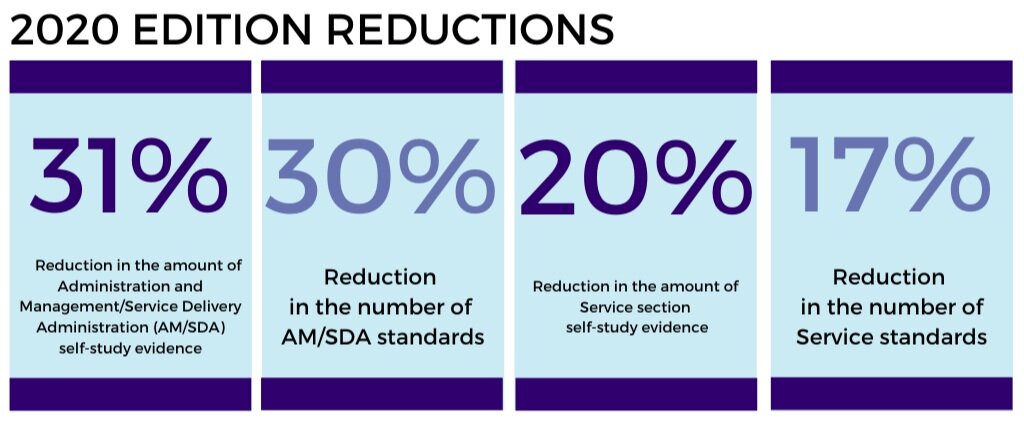
Homing in on Administration and Management (AM) standards
With the 2020 Edition, we wanted to clarify and strengthen the connection between Administration and Management (AM) standards of practice and mission fulfillment.
With that in mind, we reviewed all five of the administration and management standards, which include Human Resources (HR), Financial Management (FIN), Performance and Quality Improvement (PQI), Risk Prevention Management (RPM), and Governance (GOV), to identify and in some instances enhance the standards and evidence that will be used to assess the role each part of an organization plays in supporting impact or achieving its mission.
For a detailed breakdown of the important role each part plays in this, download our fact sheet here.
Highlighting the most important practices
As organizations familiar with our accreditation process know, Fundamental Practice (FP) standards are those standards that an organization must meet in order to achieve accreditation. With the mission impact-focus of the 2020 Edition, we have expanded the categories of FP standards to include practices that promote organizational effectiveness. FP categories now include: Health and Safety, Client Rights, and Organizational Effectiveness.
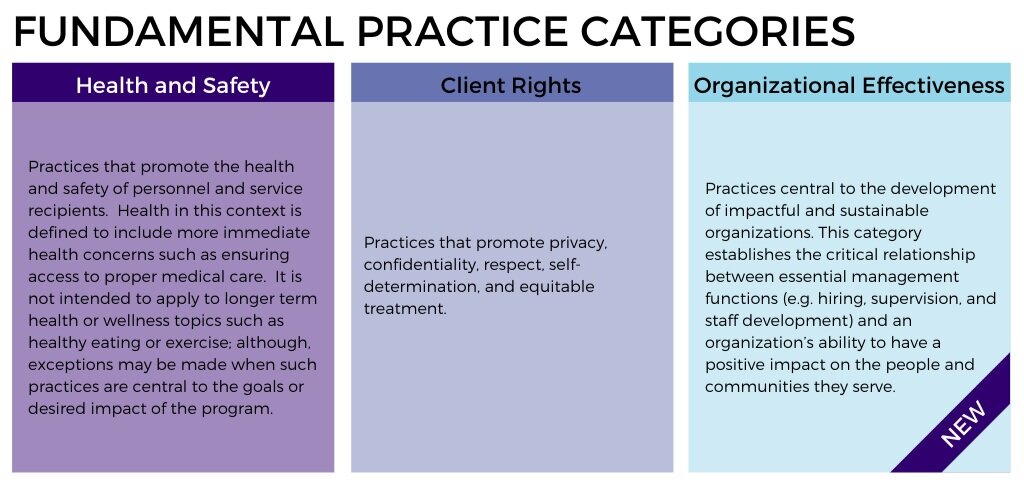
It all comes together with strategic planning
An organization’s mission serves as the benchmark by which organizational effectiveness is measured, and strategic planning is the vehicle by which an organization can move towards closing the gap between where they want to be (their mission) and where they are today. Outcomes data coming from PQI activities, HR data coming from the annual assessment of workforce needs, and risk prevention and management activities are all examples of information that feeds into the strategic planning process. Strategic planning, in turn, informs each decision that an organization makes, from budgeting decisions to hiring and personnel development decisions, with the ultimate goal of closing its mission gap.
This is why we have introduced a new Core Concept standard on Logic Models into every service section of the 2020 Standards. These standards guide organizations to think systematically about:
- The client outcomes they hope to achieve
- The ultimate impact each of their programs is intended to have
- How the program will utilize its assets and resources to achieve its goals
In other words, we’re hoping to help organizations work smarter, not harder.
These logic models denote an exciting advancement in our standards from previous iterations. To learn more about them, check out Part II of this blog series: COA 2020 Edition | FAQs about the Logic Model.
For more information on the changes in the 2020 Edition and who they affect, download our overview here. Accredited and in-process organizations can also access two recorded webinars with in-depth information in their MyCOA portal (under the tools tab). If you are new to COA and have questions about the standards or process changes, feel free to contact us!
The Interpretation blog is meant, first and foremost, to be a resource for the COA community. We had several 2019 posts that our editorial team was proud of, but wanted to take a moment to highlight those that we feel are most helpful to organizations thinking about accreditation or going through the accreditation process.
The Benefits of Organizational Accreditation

When it comes to accreditation, we at COA believe strongly in a whole-organization approach. This post explores why we do things that way and how an organization stands to benefit from looking at themselves with a holistic lens. Find the post here.
Roadmap to Preparing for the Accreditation Process

Once an organization decides to pursue (re)accreditation, it can be difficult to know what step to take first! This post does a great job of walking through the considerations of preparing your team for the process and making sure that your workflow sets you up for success. Find the post here.
PQI: A Whiteboard Video

Some of the most common questions we get at COA revolve around what “Performance and Quality Improvement” means, why we emphasize it so much, and why organizations should care about it, too. This post (and its whiteboard video!) offers a nice, succinct introduction to what PQI is and why it matters. Find the post here.
The How and Why of Strategic and Annual Planning

Developing formalized plans can seem overwhelming, so some organizations might be tempted to put it off. But planning is an important part of the accreditation process, and essential to making sure that you carry out your mission! As its title suggests, this post explores both the why and how of strategic and annual planning. Find the post here.
Top 5 Tips and Tricks for Primary Contacts

The Primary Contact (an organization contact that communicates with COA throughout the accreditation process) is key to making sure that accreditation goes smoothly. If it’s your first time through, the job can seem intimidating. Fortunately, this post (sourced from real COA Accreditation Coordinators) has plenty of tips to help! Find the post here.
Bonus: Profiles in Accreditation
If this is your first time through the accreditation process (or you just want to hear tips from other COA-accredited organizations about making the best of it!), check out our Profiles in Accreditation post series. Launched in 2019, it contains interviews from a variety of organizations who describe first-hand what they got from accreditation, how they handled the workload, and more. Checkout the series below!
- Profiles in Accreditation: Ranch Ehrlo
- Profiles in Accreditation: Rose Brooks Center
- Profiles in Accreditation: Lad Lake
- Profiles in Accreditation: Family Service Lincoln
And there you have it! What were your top posts for 2019? Share your thoughts in the comments below.
The Council on Accreditation (COA) is proud to announce the publication of our 2020 Edition Standards!
The new standards will affect private, public, and Canadian organizations seeking accreditation. When browsing the standards here on our site, look for the green 2020 Edition tag.
The COA 2020 Edition comes on the heels of valuable feedback from our volunteers, organizations, and partners. All of the work was done with a single goal in mind: to increase the value of accreditation by focusing on those practices and activities that will have the greatest impact on the people and communities COA-accredited organizations work with.
The 2020 Edition focuses on the standards that promote the development of effective, mission-driven organizations that are equipped to meet the needs of their clients. In service of that, we have refocused the standards to 1) give organizations more time to devote to those practices that have a more direct impact on clients, and 2) allow organizations to spend less time compiling evidence and more time improving practice. This means a:
- 31% Reduction in the amount of Administration and Management/Service Delivery Administration (AM/SDA) self-study evidence
- 30% Reduction in the number of AM/SDA standards
- 20% Reduction in the amount of Service section self-study evidence
- 17% Reduction in the number of Service standards
A PDF summary of the standards changes can be found here.
View the new standards online here.
If you have questions about the standards, please remember to join us in our webinar this Thursday, January 16, at 2 PM EST for a deep dive into the changes in the 2020 Edition. Register for that webinar here. A recorded version will be available for accredited and in-process organizations in their MyCOA portal after January 16.
Note: The 2020 standards will not impact organizations that are currently in-process; however, organizations can choose to opt into the 2020 standards dependent on their accreditation timeline and other factors. If you are in-process organization and have questions about the 2020 standards, please contact your Accreditation Coordinator.
Sponsorship opportunities for our 2020 conference are now open! COA 2020 will bring together more than 500 human and social service leaders at the New York Marriott at the Brooklyn Bridge August 9-11, 2020. We are honored that EveryAction has given the conference a badge designating it as one of the best nonprofit conferences of 2020.
Consider being a part of our conference to:
- Engage with conference attendees as a sponsor and attend conference events.
- Empower our attendees to better carry out their missions and serve their communities.
- Evolve the human and social services fields with innovative practice approaches.
Our attendees will include:
- Executive Directors and C-Level Executives
- Board Members
- Program and Quality Directors
- Administrators and HR Managers
Learn more about our sponsorship opportunities at coacon.org/sponsorship. Please reach out to sponsorship@coanet.org with any questions.
[vc_row][vc_column][vc_column_text]The Council on Accreditation (COA) has a new site, and a new look! We hope that you are as excited about them as we are.
THE NEW SITE
We heard that information was sometimes difficult to find on the previous version of our site. We wanted to update it to make the site work for you! Take a look around to check out some of the cool new tools we’ve got in place. We’re continuing to make updates over the next couple of months, so be sure to come back soon.
Are you part of an in-process organization or volunteer that’s looking for something and can’t find it? Please check your MyCOA or VIP portal. As part of our effort to streamline the content of the site, we have migrated certain modules over there.
Questions? Comments? Please direct them to webmaster@coanet.org.
THE NEW LOOK
In our more than forty-year history we have only had three logos – the most recent being the Council on Accreditation (COA) shield that launched in 2012 which was an adaptation of a 2002 version. So, we thought with all the excitement surrounding our 2020 Edition standards, coupled with welcoming our new president and CEO, that the time was right to give our branding a refresh.
It was not something that we took lightly, and many, many months of planning and design went into getting it just right. We wanted to make sure that we were remaining true to our roots but elevating the look and feel to be more fresh, modern, and meaningful. Learn more about our thought process behind the branding updates on our blog.
Please note that as we go about finalizing these updates, you may still find some documents with our old branding. Pardon our mess! We have a lot of tools for you, and are working on getting them all updated as expeditiously as possible.
Welcome to the new COA![/vc_column_text][/vc_column][/vc_row]
Welcome to the Council on Accreditation (COA) blog post series Profiles in Accreditation!
The organizations that COA accredits are diverse in both the communities they serve and their reasons for seeking accreditation (or reaccreditation). Profiles in Accreditation will explore the accreditation experience through the perspective of these organizations. Through them, we can discover the value of accreditation, best practices, lessons learned, and recommendations.
Organization profile
Name: Rose Brooks Center
Location: Kansas City, Missouri
First accredited: 2018
Snapshot:Rose Brooks Center is a domestic violence agency serving the Kansas City Metro-Area. Its mission is to break the cycle of domestic violence so that individuals and families can live free of abuse.
Rose Brooks Center services include a 24 hour crisis hotline; a 100-bed emergency shelter for adults, children, and their pets; individual and group therapy services; a supported recovery program; advocacy services co-located within 5 hospital systems, civil and criminal courts, and the police department; a rapid re-housing program; residential and non-residential case management services; employment and economic advocacy; a school-based violence prevention program serving over 30 local schools; and community training and education.
Interview with Rose Brooks Center
For this Profiles in Accreditation post, we asked Chief Operating Officer Lisa Fleming to share her experience heading up the accreditation process at an agency becoming accredited for the first time. Lisa emphasized how accreditation has enhanced Rose Brooks Center’s quality improvement and risk management processes, and how the hard work of the Self Study can pay off.
COA: Why was seeking accreditation important for your organization?
LF: For several years, Rose Brooks Center had the goal of obtaining accreditation in our strategic plan. We were fortunate to have a local funder, the Jackson County Community Mental Health Fund, that offers agency capacity-building grants for improving mental health outcomes. Specifically, they provide funding to grantees to pay for accreditation fees. Since the early 90’s, the Mental Health Fund has provided Rose Brooks Center with leadership and guidance in using outcome data and quality assurance indicators to make improvements to our funded programs. Their capacity-building grant helped to ensure we moved to the next level of fully implementing best practice standards and building out our quality improvement process.
We recognized that accreditation would be the next step for ensuring quality services. It would also be important to sustaining a culture of quality improvement. While we had general policies and procedures in place for agency operations, we knew we would benefit from the structure and researched best practice standards offered by COA.
In addition, we have benefited from the institutional knowledge of several agency leaders who have been here for twenty or more years. As we planned for the next five to ten years, we knew that there needed to be a way of transferring this institutional knowledge and formalized processes for ensuring quality.
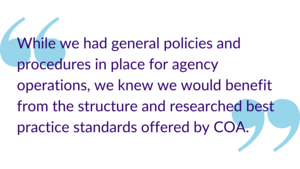
COA: What about the COA accreditation process made you decide to partner with us?
LF: There were several factors that influenced our decision to partner with COA. First, the COA process includes standards specialized for domestic violence services and emergency shelter operations. These standards reflect guiding principles of trauma-informed care and the standards set forth by our state domestic violence coalition.
Two of our local domestic violence agency partners had also selected COA and highly recommended COA. We benefitted from their lessons learned and work product as we conducted our Self-Study. We hope to pay it forward to another domestic violence program considering COA.
The consultation with our Accreditation Coordinator was a benefit that was not originally factored into our decision, but certainly was one that was extremely helpful and valuable to our self-study process. We always highlight this service to other agencies who are in the process of selecting an accreditor.
COA: Were there any unexpected results after completing the Self Study and Performance and Quality Improvement (PQI) process?
LF: The level of staff participation throughout the Self Study and ongoing PQI process has exceeded our expectations. It has been a valuable and effective way to instill a culture of improvement throughout the agency, and it has offered a professional development opportunity for staff who have an interest in program management. Recently, a PQI Team member expressed her interest in being a full time PQI Coordinator if the position was ever created. It was a result affirming our original goal of sustaining a culture of improvement.
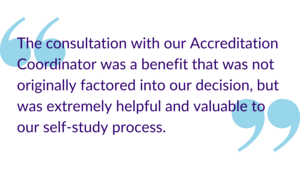
COA: How did you engage and communicate the value of accreditation to the entire organization during the accreditation process?
LF: We used many of the Intensive Accreditation Training and Performance and Quality Improvement Tool Kit documents to train staff, agency leadership, and the board. At our first staff training we used the Culture of Improvement document, and staff shared examples of Rose Brooks Center practices that supported each component of a culture of improvement. The activity and document helped connect staff to the things they do on a regular basis but may not have considered to fit with the more formal definition of Performance and Quality Improvement. We did a similar presentation with our board to share the benefits of accreditation, explain the self-study process, and train on the new or updated policies and procedures.
COA: What do you see as the main benefit of COA accreditation?
LF: COA accreditation sustains a foundation of research-based best practices throughout our organization. This helps to ensure that our agency achieves our intended outcome goals, exceeds our indicators for service delivery quality and safety, and manages agency operations with the highest degree of ethical and fiduciary standards. The accreditation process and resulting new or updated policies and procedures continually inform and guide our program development and improvement, training and professional development, risk prevention and management activities, and overall agency capacity building activities.
COA: What about the accreditation process do you feel was most valuable to your organization?
LF: Establishing routine and formalized processes for agency-wide performance and quality improvement and risk prevention and management that will be sustained long-term. Concurrent to the self-study process, our agency has continued to work on succession planning and staff professional development. Several staff with over 20 years of institutional knowledge will retire within the next 5 to 10 years. The accreditation process has been incredibly effective in transferring the institutional knowledge, expertise, and processes that have resulted financial stability and quality services to the next generation of leaders.
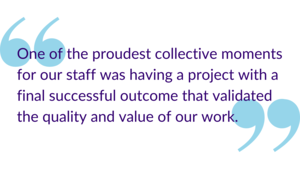
COA: What did you like most about the accreditation process?
LF: One of the proudest collective moments for our staff was having a project with a final successful outcome that validated the quality and value of our work. Seeing the volume of evidence describing all that staff do on a daily basis was a pretty great feeling.
We appreciate having the researched-based standards offered by COA, as well as the flexibility and empowerment to create agency procedures that can both fulfill the requirements of the standards and be customized to meet the unique needs our workforce and the people we serve.
COA: What was the biggest challenge during the accreditation process?
LF: Managing a full time position while working a project that could in itself be a full time job position. It’s worth it. But it’s a lot. Thankfully, I had a great team of supervisors and staff to help with the project. We also appreciated the help from Sabrina (our Accreditation Coordinator) in determining a reasonable timeline for completion.
COA: How has COA accreditation/reaccreditation impacted operational success?
LF: COA accreditation has formalized our Performance and Quality Improvement (PQI) and risk prevention and management processes. In turn, we have been able to include these up-to-date recommendations and improvement needs into multiple grant proposals. The monitoring and improvement processes provide our grant writers with timely, detailed, and substantiated Statement of Need for a wide variety of local, state, federal, and foundation grants. We have been awarded funding for program enhancements, staff training, equity and inclusion consultation services, facility and security improvements, and client supplies using PQI and risk prevention and management data.
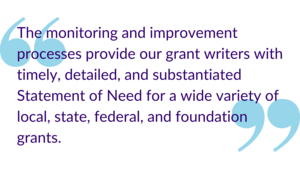
COA: What are the top three pieces of advice or tips that you would give to an organization considering or currently undertaking the accreditation process for the first time?
LF:
1. Use the tools, documents, training, and consultation offered by COA. Our monthly meetings with our Accreditation Coordinator, Sabrina, were extremely helpful to increasing our understanding of the standards and thinking through what needed to be developed or what existing procedure could be adapted to fit with a standard. They were also a reassurance that COA’s goal was to help us successfully achieve accreditation.
In addition, I would also recommend sending the staff person with the primary responsibility for coordinating the self-study to the in-person Intensive Accreditation and the Performance and Quality Improvement training offered by COA.
2. Reach out to another similar agency who has gone through COA’s self-study and site visit process. Most are very willing to share their policies and procedures. It can really help you get past a “writer’s block” and get you started. Likely they can help re-assure you about the process and its benefits.
3. Designate a leader and a team that has an expansive and detailed knowledge of agency operations to coordinate the self-study process. At first we hired a consultant to do the coordination, but the volume of concurrent projects, processes to be developed, and constant communication proved challenging for an external position. For our agency, it worked best to have the COA Coordinator (our Chief Operating Officer) develop a timeline and document checklist using the COA tools. The COA Team, comprised of program directors and the Executive Team, met at least monthly to review progress. Program directors involved their team members to update or create program-specific procedures.
COA: Are there any other learnings or insights that you’d like to share?
LF: Personally, the self-study process was one of the most challenging projects I have worked on in my 28 years at Rose Brooks Center. It is also one that I take the most pride in having led. As an Executive Team, it has given us increased confidence that the culture of improvement and our commitments to safety, quality, trauma informed- care, and equitable and inclusiveness will be sustained.
Thank you, Rose Brooks Center!
We would like to thank Lisa for her thoughtful insights into the first-time accreditation process and acknowledge the entire Rose Brooks Center board and team for embracing accreditation and collectively contributing to the promotion of best practices. Thank you, all!
Do you have a COA accreditation story to tell? Click here to share it. You could be the next organization we feature!
So, you’ve been designated by your organization as the Primary Contact—the point person for communicating with the Council on Accreditation (COA) and spearheading the accreditation process. Maybe you’re feeling a little overwhelmed; you might not be sure about the best way to get the job done. Fear not! We’re here to help with tips on how to make the process as smooth as possible, whether this is your first time managing the accreditation process or your fifth.
1) Get organized

If we were to create a job description for the Primary Contact role, strong organizational skills would be first on the list of required traits. You need to be able to organize, prioritize, and project manage. This includes assessing the scope of the work, identifying available/necessary resources, and planning for the completion of tasks while working towards deadlines.
There are a lot of moving parts during the accreditation process, so it is critical to stay on top of due dates and important notifications from COA. You also need to make sure that these are communicated within your organization, and that you clearly outline expectations regarding the workload and workplan for other staff to maintain efficiency.
Sound like a lot? Don’t worry! We have some resources that can help those efforts. Here are a few to get you started:
- SELF-PACED TRAINING: Getting Organized/Creating a WorkplanThis self-paced training provides guidance on coordinating and managing the work of the self-study process, with the goal of developing a comprehensive accreditation work plan.
- BLOG POST: Roadmap to Preparing for the Accreditation Process Another handy, step-by-step guide to help you get a handle on the various tasks involved with accreditation.
- BLOG POST: Creating Effective Workgroups on the Road to AccreditationGet tips on how to organize and delegate work to different staff.
- MYCOA PORTAL: Your Standards and Self-Study StepsWe built the MyCOA Portal with the goal of setting you up for success. The Standards & Self-Study tab (option five in the blue navigation bar at the top of the screen) is one good example of this: it features a checklist of steps to complete during the Self-Study process; a progress bar to help you track how you’re doing; and links to important documents to help you along the way.
2) Communicate clearly and often

The accreditation process centers around good internal and external communication.
From an external standpoint, as the Primary Contact you are responsible for overseeing all communications between your organization and COA. Whether it is over the phone or email, it is essential to keep your Accreditation Coordinator in the loop about any significant program updates or organizational changes.
From an internal standpoint, it is important to have staff, management, and your governing body appropriately informed of the process. This will not only help everyone work together to get things done, but also ensure that accreditation’s benefits are felt organization-wide.
Pro tip: Maximize your relationship with your Accreditation Coordinator
COA partners with organizations throughout the accreditation process. A key component of that partnership is the relationship between the Accreditation Coordinator and you, the Primary Contact. Here are a few suggestions on how to capitalize on this unique benefit.
- Schedule – and really use to your advantage! – a monthly call, especially if it’s your first time going through the process. Having the time carved out on your calendar ensures that you have time specifically dedicated to accreditation each month. (Ex: “I have my call with my Coordinator next week and I haven’t looked at the FPS standards yet – let me get on that now!”) We understand that everyone has a million things going on in addition to accreditation, so blocking off time for checking in and asking questions is one way to stay on top of things.
- Check out our extensive accreditation resources first before bringing any additional/clarifying questions onto your call. This will make sure that you’re using your time with your Accreditation Coordinator as productively as possible.
- Involve other staff members in the monthly calls. Not only can this be a more efficient way to get everyone on the same page, but it also makes the process more team-driven and rewarding. This allows other staff members to “get to know” the COA voice on the other end of the phone to experience the partnership firsthand.
- Whether for scheduled calls or when staying in contact in general, it is helpful for Accreditation Coordinators when Primary Contacts gather and send questions all at once, especially very specific standards questions. This is particularly beneficial when it comes to monthly check-in calls. If questions are sent over (in one email) a few days before the call, it gives the Accreditation Coordinator time to prepare and touch base with their team/the Standards Development Department as needed, which maximizes your time and makes for a productive conversation.
3) Be transparent

Transparency is another critical factor to your success as a Primary Contact. This goes hand in hand with being a good communicator.
We often say that the Self-Study process is like holding a mirror up to your organization. This works best for everyone when the mirror is a clear one! Your Accreditation Coordinator is there to provide technical assistance and targeted support, but they can only do so if you communicate honestly about your struggles so that they can help you navigate your pain points. Identify your organization’s needs and be eager to ask questions.
This advice applies when communicating within your organization as well. Often, we find that one staff member doesn’t always hold all the knowledge/documents that are necessary to complete the accreditation process; therefore, it is important that you approach other staff and pull them in as a resource when needed.
4) Get involved

We’ve already highlighted the importance of working with your Accreditation Coordinator – they are there to answer questions, interpret the standards, and guide you through the process. But don’t forget about all our other resources that are there for you to tap into!
If it’s feasible time- and budget-wise, attending our live Intensive Accreditation and Performance and Quality Improvement trainings can be very impactful, particularly if you or your organization are new to the accreditation process. We hold these trainings a few times a year. They are a great resource not only for taking a deeper dive into managing accreditation and learning strategies to enhance your PQI system, but also for networking with (and learning from!) colleagues that are in the same boat as you. Attending these is not a prerequisite for being a stellar Primary Contact, of course, but they are helpful if you can make it to them.
COA also has a plethora of self-paced trainings, tip sheets, tool kits, and more. Your MyCOA Portal will offer suggestions of which of these will work best for you at different points in the accreditation process. Be sure to use it! You will find everything that you need there to successfully navigate the process. The portal is secure, customized and will always include the specific information that is relevant to your organization.
Digging into these resources will provide you with a good overview of 1) how COA is going to review your organization, and 2) all the major milestones you need to hit along the way. This will help you to grasp the amount of work needed and the different deadlines that your organization is going to approach. Knowing these will help you guide others in your organization toward success.
Pro tip: Find your tribe
COA lists all our accredited organizations on our public website. Use the Who is Accredited Search to find peer organizations by location or service area. This practice can help you create a network and empower you and other Primary Contacts to access resources, share information, and ultimately make the most out of the accreditation process.
5) Be an accreditation cheerleader

Getting through the accreditation process is all about creating and maintaining momentum with your team. COA’s review is very comprehensive, and so it includes many potential ways for different staff to participate. Establishing and championing those opportunities can contribute to making accreditation more fun, rewarding, and successful.
We encourage Primary Contacts to tap into their creative side. Try developing a game that incorporates COA’s accreditation standards or creating a fun visual that tracks your progress. Your job is all about being a good motivator, so celebrate the victories both big and small. With as hard as you’re working, you all deserve it!
Though being a Primary Contact can feel like a lot of responsibility, rest assured that accreditation is by no means a one-person job. The process–from pulling together Self-Study evidence to preparing for the Site Visit–should be a team effort. Your role, then, is of a team captain. With these tips, we hope you can get out there and lead your crew to success!
Further reading
If you want to do a deeper dive, we’ve pulled together some additional resources below. Don’t forget to also check out those linked directly in your MyCOA portal.
- Accreditation Learning Plan
- Preliminary Self-Study Fact Sheet
- Three-Part PQI Recorded Webinar Series
- PQI Tool Kit
- Intro to Logic Models
- Governance Standards Tool Kit
- Policies and Procedures Checklist
- Preparing for the Site Visit
Welcome to the Council on Accreditation (COA) blog post series Profiles in Accreditation!
The organizations that COA accredits are diverse in both the communities they serve and their reasons for seeking accreditation (or reaccreditation). Profiles in Accreditation will explore the accreditation experience through the perspective of these organizations. Through them, we can discover the value of accreditation, best practices, lessons learned, and recommendations.
Organization profile
Name: Family Service Association
Location: Lincoln, Nebraska
First accredited: 1998
Latest reaccredition: 2019
Snapshot: Family Service is a nonprofit organization that has been providing services to the families of Lincoln, Nebraska for 125 years. They recently updated their mission to be “Helping Families Thrive.” Currently, Family Service provides families with four programs: Women, Infants, and Children; Child Care Food; Behavioral Health; and Out-of-School Time, which includes before- and after-school care, as well as summer care.
Two of Family Service’s four programs are accredited with COA: Behavioral Health and Out-of-School Time. Their Out-of-School Time program is their largest program. It consists of 14 before- and after-school care programs and seven Community Learning Center programs. Their Behavioral Health program provides licensed therapists to 22 schools within Lincoln Public Schools and six schools in Saunders County. It also includes of a Community Response Program, which connects families with community resources that will support families to meet their goals and strengthen relationships within the community.
Interview with Family Service Lincoln
For this Profiles in Accreditation post, we asked Director of Strategic Initiatives Jessica Radford, Ed.D. to share her experience at an organization that has been accredited by COA for the last ten years. Jessica told us how reaccreditation has helped drive the organization’s quality improvement forward. She also shared how she appreciated how COA accreditation felt not like an evaluation via checklist, but an effort from a team.
COA: What were some of the drivers for seeking reaccreditation this latest time around?
JR: It was important for our organization to seek reaccreditation to learn how quality programs and services are defined and to help us identify areas of growth. All our Management Team was new within the past two years. Reaccreditation provided us with the opportunity to really dig into the organization and its practices. We learned what was done historically, what was currently being done, and how we could improve it.
Accreditation helped us to evaluate and update practices that are oftentimes overlooked. Some of these included safety and risk assessments, HR audits, and an annual review of policies and procedures. It also helped us evaluate our system for communicating with staff and involving stakeholders. Sometimes we forget to evaluate our common organization practices and their effectiveness because we just keep doing things the way they’ve always been done. Accreditation helped us hone in on these practices and improve them.
COA: What about the COA accreditation process made you decide to partner with us?
JR: Our organization has been accredited with COA for the last ten years, and the staff take great pride in this accreditation. COA holds their organizations to high standards and has a rigorous accreditation process. So it was important for Family Service to continue this accreditation with COA for consistency, as well as to ensure we were providing good services to employees and families.

COA:How did you engage and communicate the value of accreditation to the entire organization during the accreditation process?
JR: We held a kick-off meeting where we brought everybody together and talked about the importance of accreditation, the process, and the role they would play. We provided updates through emails and meetings. When we received our accreditation, we had a cookie celebration and invited the board and stakeholders.
COA:What do you see as the main benefit of COA accreditation?
JR: The main benefit for us through our COA accreditation was the framework for evaluating and improving the organization and its practices. Sometimes it can feel overwhelming, not knowing where to begin with improvements or trying to identify what needs to be improved. COA provided a very thorough framework for us to follow, allowing us to assess the organization and its practices comprehensively so that we could target areas to work on. The standards also provided guidance for how to make improvements and what best practices are for nonprofit organizations.

COA: What about the accreditation process do you feel was most valuable to your organization?
JR: All of it. 😊
The standards were easy to understand and provided clear guidance. The staff at COA were very responsive and helpful. They always responded within a day anytime I emailed or called them, and they always had an answer for me. They were also very willing to take the time to help me and make sure I understood the process and standards.
The feedback given to us from our on-site reviewers was also very valuable and appreciated. For example, the on-site reviewers talked with us about the training of the organization. Following this conversation, we purchased an online training system and began implementing it. The system communicates with staff, tracks training completion, and provides lots of training options to staff.
COA: What did you like most about the accreditation process?
JR: I liked all the guidance that was provided through the accreditation process. The standards were very easy to understand and provided lots of explanations through the Interpretations. The staff at COA were so knowledgeable and helpful. The Intensive Accreditation Training was full of great information and guidance. Our on-site reviewers provided lots of great feedback on areas we can improve. The process really felt like a team effort.

COA: What was the biggest challenge during the accreditation process?
JR: Organizing all the evidence. 😊
I found it helpful to organize the standards and evidence into tables. I put together tables with three columns: Standard, Required Evidence, and Family Service Evidence. This helped me to keep track of what document went with what standard and to be sure I provided evidence for each of the areas of Required Evidence. It helped me organize it into more of a checklist.
COA: How has COA reaccreditation impacted operational success?
JR: The reaccreditation has really helped drive our quality improvement forward. It has given us specific areas to improve on and helped us set goals and objectives. It’s only been a few months since we received our accreditation and we have already made some great improvements.
Because of our accreditation, we have worked to improve the training we provide our employees. We have created an onboarding process which includes some safety trainings and some behavior trainings. We have created an annual training plan which includes monthly safety trainings for all staff and bi-monthly supervision trainings for all supervisors. The system we have implemented tracks trainings completed by staff in one on-line system. This has helped us to keep track of trainings as well as identify training needs for staff. This has not only improved our training program, but also the culture at our organization. Staff now feel that safety and training is a priority to Family Service.
We have also become more aware and thoughtful about reviewing our practices on a regular basis. We have implemented annual HR audits, stakeholder meetings and surveys to get feedback on our programs, annual reviews of policies and procedures to make sure they reflect what we are doing, quarterly safety checks and risk assessment reports, and improved data collection to help us analyze practices and programs.

COA: What are the top three pieces of advice or tips that you would give to an organization considering or currently undertaking the accreditation process for the first time?
JR: The coordinator of the process needs to be a very organized person. A large part of the process is collecting and organizing evidence to be submitted. If the person is already good at organizing projects and information, setting deadlines, and delegating duties, this will make the process less overwhelming.
Use your COA team. Do not be afraid to ask questions. Everybody on our COA team was so helpful. It felt more like a team effort instead of an evaluation and checklist.
Use the process as an opportunity to identify areas of growth. Do not try to look perfect for COA. Be honest about your practices and procedures. This will help you use the process to identify areas of growth and make improvements.
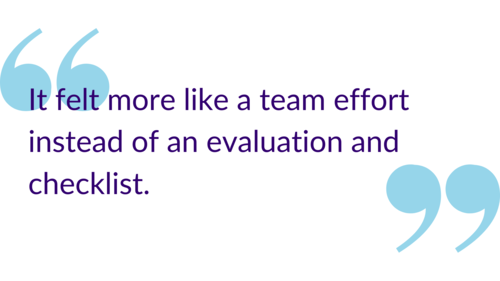
COA: Are there any other learnings or insights that you’d like to share?
JR: I cannot say enough good things about our accreditation team. Mary Glenn was amazing, and I couldn’t have done it without her. She was always so helpful and knowledgeable. Even when I felt overwhelmed or like we were doing things wrong, she helped guide me and reassure me that we were on the right track with things.
Our on-site reviewers were so pleasant and knowledgeable as well. They did a wonderful job at the introductory meeting explaining accreditation and the process to our board and staff. All our staff enjoyed having them on site and talking with them. Their feedback during the exit meeting was so valuable as well. It really gave us areas to improve on.
When we received our final accreditation report, nothing was a surprise because everybody had been so transparent through the process. It was really a team effort to get our accreditation, and COA was a big part of that team.
Thank you, Family Service Lincoln!
We would like to thank Jessica for her thoughtful insights into the reaccreditation process, and acknowledge the entire Family Service Lincoln board and team for embracing accreditation and collectively contributing to the promotion of best practices. Thank you, all!
Do you have an accreditation story to tell? Click here to share it. You could be the next organization we feature!
I’m going to go out on a limb and say it: Mental Health is IN right now. Everyone from meme accounts to rappers is talking about it, and working on your emotional well-being no longer has the same taboo it once did. In fact, some might go so far as to say that your emotional health is intertwined with your physical health (and those of us in the human services field are probably nodding our heads vigorously at this one). Then it follows to reason that if both aspects of our health are equally important, they deserve equal insurance coverage. But is that what’s happening?
Like most things in the world of behavioral health, the answer is….kind of. In 1996, the Mental Health Parity Act was signed into law. It dictated that the annual or lifetime dollar limits in health insurance coverage be equal to medical and surgical benefits. Did this happen? Short answer, no. Long answer, insurers continued to lead policy and utilized the levers at their disposal to reduce costs and ultimately limit coverage. Employers and insurers began to put a larger emphasis on cost sharing, limits and caps on the number of visits with a care provider or number of days in a hospital were imposed, and benefits didn’t extend to substance use treatment. This led to the 2008 passage of the Mental Health Parity and Addiction Equity Act (MHPEA), which gave advocates hope that further protections were being put in place to ensure equal coverage for behavioral healthcare. So now that it’s 2019, are we actually seeing parity?
MHPAEA 10+ years later
Reflecting on the decade-plus since its passage, what has the MHPEA done for health care coverage? The act has done several important things: it made sure that substance use treatment was included in the parity conversation, it protected mental health and substance use services from being subject to more restrictive cost-sharing and treatment requirements, it ensured equitable coverage for out-of-network treatment, and it gave patients the right to request information regarding medical necessity determinations and reasons for coverage denial. Despite these important steps forward in the battle for parity, implementation hasn’t been easy. Behavioral health providers are seeing 17-20% lower reimbursement rates than their medical counterparts, and the oversight varies wildly from state to state. Advocates such as Angela Kimball from the National Alliance for Mental Illness applaud the Federal law for paving the way for the removal of many of the traditional barriers to mental health treatment, but still feel “much more subtle discriminatory practices” remain an issue.
The “much more discriminatory practices” are what experts refer to as non-quantitative treatment limitations, which includes differences in how plans enact utilization management and define medical necessity, separate deductibles and co-pays for behavioral health services, limited options for in-network behavioral healthcare providers, and lower reimbursement rates. According to the Milliman Research Report on parity laws, this has resulted in decreased reimbursement rates for these provider’s services and approximately 32% of patients going out of network for treatment (in comparison to the 6% of patients that go out of network for their medical services).
Parity at the state level
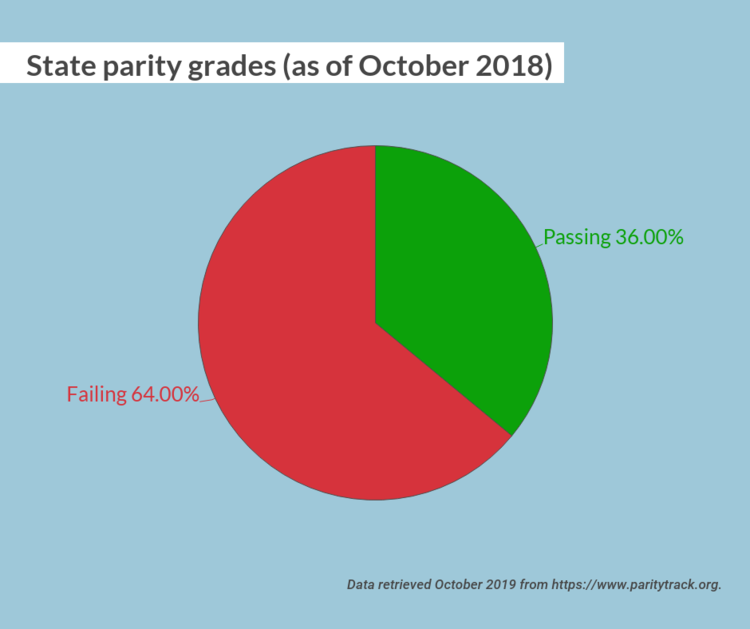
One major road block was inconsistent oversight and implementation at the state level. As recently as October 2018, 32 states received a failing parity grade. However, the state of Illinois was a star pupil, with a 100/100 grade. Illinois went above and beyond Federal parity policy by passing Public Act 99-480, which expands upon the MPHEA with provisions to extend coverage, provide education to the public about their rights, require minimum treatment benefits, and strengthen oversight and enforcement of the law. The Illinois statute extended applicability to plans not covered under the Federal parity law, such as fully insured plans for small employers and state and local governmental plans. It also extended the opioid antagonists covered in the plan. In addition, the legislation required the Illinois Department of Insurance to develop a plan for a consumer education campaign on mental health and addiction parity in order to help consumers, providers, and health plans better understand parity under the law. Finally, the law created an interagency workgroup and clarified the enforcement authority as the Department of Insurance. It’s this last piece, the interagency workgroup and clarification of enforcement, that promises continued success for Illinois parity. It promotes continual work, reflection, and analysis of Illinois’s parity statutes and clear delegation of responsibility.
The state of New York is an example of a state who has struggled with parity implementation but is actively trying to bolster its own Mental Health Parity laws. The Mental Health and Substance Use Disorder Parity Reporting Act was signed into law on December 22, 2018, and creates a reporting mechanism for health plan information to the Department of Finance to increase oversight of behavioral health management companies. The insurers will submit data to the department in order to keep track of potential non-qualitative treatment limitations. This is an important first step to identifying bad insurance coverage policy and protecting consumers.
Illinois and New York aren’t the only states who are working towards true parity for behavioral health coverage. Pennsylvania has identified and fined a large insurance company and its subsidiaries for imposed behavioral health treatment, and Wyoming and New Jersey both recently enacted policy for insurers to meet MHPAEA requirements. While the United States might not be at a point where we can safely say we are full parity across the nation, states are taking the steps to get there.
What can I do about health parity?
Glad you asked! For starters, call your legislators! The following states have introduced model parity legislation; contact your state senators and representatives to let them know you want them to support health parity: California, Florida, Maine, Massachusetts, Minnesota, Mississippi, Missouri, Montana, and Nevada.
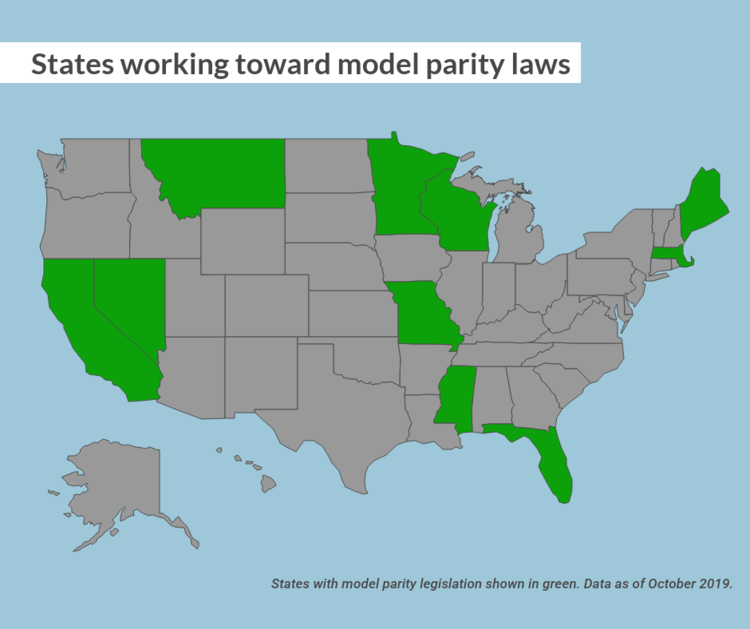
Don’t see your state here? The American Psychiatric Association has you covered with model parity laws for every state!
At the Federal level, there are several bills that could use your support. Contact your senator or house representative and let them know you support the following bills:
- The Mental Health Parity Compliance Act (S. 1737/H.R. 3165)—This would require comparative analyses about the design and application of managed care practices. That information would then be collected by federal agencies, who would analyze the plans’ compliance, specify what must be done to bring it into compliance, and submit an annual report of their findings.
- Parity Enforcement Act (H.R. 2848)—This bill authorizes the Department of Labor to issue monetary penalties for those violating the federal health parity law.
Reach out to your senators and representatives! Make sure that your state is providing you the best behavioral health coverage possible. Your mental health is just as important as your physical health, and it should be covered. The MHPAEA was an important step in the fight for parity, but we are a decade out from its passage and have learned lessons about the act’s limitations. We should be using those learnings to get us closer to full parity.
October is Domestic Violence Awareness Month. An estimated one in three women and one in four men experience some form of domestic abuse over the course of their lives. For those in a physical, emotional, or sexually abusive relationship, escaping from a cycle of power, control, exploitation, or violence can be a daunting challenge.
Outsiders often question why someone would stay in a situation that inflicts physical, emotional, and physiological harm. However, walking away from an abusive environment is incredibly complex. The dynamic between the person inflicting violence and the person experiencing violence in and of itself complicates the path to safety. Given that domestic violence is rooted in power and control, leaving an abusive situation can be the most dangerous time for a victim/survivor.While danger and fear are prominent factors, there are several other reasons why individuals do not leave – love, shame, children, cultural/religious beliefs, and financial resources are compelling forces.
Advocates are also calling attention to one important but often overlooked factor: pets.
Why pets matter
If you are an animal-lover, it may not be surprising to hear that victims/survivors frequently cite concerns related to their pets or companion animals as part of their decision to stay. Pets become part of the family and provide comfort and companionship, creating an emotional bond that is hard to break. In times of crisis, that bond intensifies.
Studies vary, however, research over the years has indicated that between 20 to 65% of domestic violence victims delay leaving their abusive partner out of fear of harm to their animals, who can be exploited in exchange for the victim’s compliance and silence. Abusive partners commonly use pets to exert power over victims by threatening to hurt or fatally harm the animal if their partner leaves. A strong body of evidence also links a history of animal cruelty to domestic, child, and elder abuse and mass violence, with many experts regarding animal cruelty as a precursor to violent crime. One study found that 71% of pet-owning women entering women’s shelters reported that their abusive partner had injured, killed or threatened family pets as a form of psychological control or revenge.
Although the relationship between domestic violence and animal abuse is clear, survivors with pets face extremely limited options; most shelters and housing options do not allow pets. This may be in part due to the obstacles associated with pet-friendly, co-sheltering models. Resources alone are a significant barrier, given the supplies, services, and accommodations needed to house survivors and their pets safely. There are also legal and liability concerns related to caring for animals and humans in a shared environment. Navigating physical and physiological factors, including consumers’ fear of animals and animal behavior, require special considerations when it comes to service delivery, staff training, and community outreach.
Currently, it is estimated that only 10% of all domestic violence shelters nationwide accommodate companion animals. As of September 2019, five states – Hawaii, Mississippi, New Hampshire, Rhode Island and West Virginia – do not have any pet-friendly domestic violence shelters. This overwhelming unmet need is a significant barrier to seeking safety for pet-owners affected by domestic violence.
Rising to the challenge
Recognizing that pets factor into a victim/survivor’s journey, advocates and providers are working towards addressing the need for pet-friendly programming and policies. Organizations are thinking outside the box when it comes to partnerships and service delivery to bridge the gap.
Housing is a substantial roadblock. In response, organizations are implementing innovative approaches to provide pet-inclusive shelter programs, including on-site kennels or pet-friendly facilities. Other providers are looking within their local communities to help survivors find foster homes or safe havens for their pets off-site.
Pet-friendly programming
• Rose Brooks Center is a COA-accredited organization located in Kansas City, MO. It became the first domestic violence shelter in the region to accommodate animals when it opened its pet shelter in 2012. The pet shelter offers a safe on-site environment along with pet advocates, and owners have 24/7 access to their pets. In August 2019, Rose Brooks Center was honored by The Kansas City Animal Health Corridor for its commitment to protecting animal welfare and survivors of domestic violence.
• In October 2018, COA-accredited Women in Distress opened its pet shelter in partnership with the Humane Society of Broward County. The shelter is the first of its kind in Florida and can house up to 20 pets in its kennels, while survivors reside on the organization’s 132-bed campus. In addition to safety, pets receive daily care and medical treatment on-site.
• Urban Resource Institute (URI), one of the largest providers of domestic violence shelter and support services in New York City, opened the country’s first-ever domestic violence shelter specifically designed for survivor-pet co-living. PALS Place is a seven-story emergency shelter in Brooklyn that provides 30 one- and two-bedroom apartments for up to 100 survivors and their pets.
In order to increase access to services for victims/survivors and their pets, it is essential to promote policies that address companion animals in the context of domestic violence. The Pets and Women Safety (PAWS) Act, passed with bipartisan support in December 2018, was a big step forward at the federal level. In addition to expanding federal domestic violence protections to include protections for the pets of domestic violence victims, PAWS created a federal grant program to help providers offering shelter or housing assistance options to survivors with pets.
Break down barriers to pet-friendly service delivery
Research and anecdotal evidence confirm the impact of animals on human wellness and functioning. The therapeutic benefits of companion animals are well-known. Pets provide tremendous emotional support and a sense of stability and protection to their owners. For survivors of domestic violence, that care and comfort can be critical to the recovery process, which is why the need for pet-friendly shelter options is so great. The power of human-animal connectedness can help survivors navigate difficult periods of change and overcome challenges (both practical and trauma-related).
Want to help raise awareness about this issue in your community? Here are some resources and recommendations for providers and individuals interested in learning more.
Find housing assistance for survivors with pets
Looking for shelter options that accommodate pets in your community? The resources below provide links to a variety of providers as well as groups that offer financial assistance to cover costs associated with housing companion animals.
Pet-friendly housing resources
• The Animal Welfare Institute (AWI) created an interactive, comprehensive list of safe havens for pets. AWI’s Safe Havens Mapping Project for Pets of Domestic Violence Victims provides a state-by-state listing of shelters that accommodate pets and providers that can provide referrals to such facilities.
• Red Rover offers financial assistance for families and pets affected by domestic violence through their RedRover Relief program. Survivors can apply for a Safe Escape grant, which covers the cost of temporary pet boarding while they’re in a domestic violence shelter. The organization also has an online directory, Safe Place for Pets, that provides linkages to on-site and off-site housing options and community programs for victims/survivors with pets seeking safety.
• Sheltering Animals and Families – Together (SAF-T) provides a concise, up-to-date list of pet-friendly domestic violence shelters in every state.
Explore ways to build capacity and partnerships
If you are a provider that is interested in expanding services to accommodate the needs of victims/survivors and their pets, there are tools and resources that can help you adapt your facilities to becoming pet friendly. Through their recent work, URI created a whitepaper full of lessons learned, including the importance of developing an educational plan and safety protocols to help alleviate potential areas of risk and concern. SAFT-T also developed a start-up manual that outlines different housing models and legal and financial considerations. There are several funding opportunities available to nonprofits based on how they are looking to support survivors. The Purple Leash Project, a partnership between Red Rover and Purina will provide $500,000 in grants to transform domestic violence shelters into safe spaces for survivors with pets over the next four years, with the goal of establishing a pet-friendly shelter in all 50 states by 2020.
Don’t have the resources required to provide pet-friendly services on-site? You can still build on your capacity to support victims/survivors in ensuring their pets’ safety.
For example, integrating animal/pet-related questions into the intake, screening, and/or assessment process can help organizations better identify potential barriers and connect victims/survivors to appropriate housing options. Safety planning is another opportunity to be pet-inclusive on a victim/survivor’s path to safety; workers can empower individuals to make decisions about their pets’ care and address needs such as emergency shelter, proof of ownership, veterinarian records, and protective orders.
Additionally, it is important to familiarize staff with pet-friendly alternatives in the community in order to refer victims/survivors whenever possible. If there are a lack of supports readily available in your area, consider connecting with your local animal shelter to explore potential partnership opportunities to offer other safe options for pets off-site.
Additional resources
- National Domestic Violence Hotline
- National Coalition Against Domestic Violence
- National Resource Center on Domestic Violence
- National Link Coalition
- NDVH/URI survey about safety planning
For anonymous, confidential help available 24/7, call the National Domestic Violence Hotline at 1-800-799-7233 (SAFE) or 1-800-787-3224 (TTY) now.
